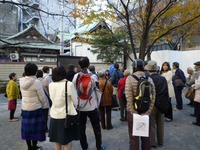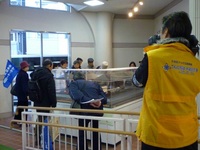"Autumn Chuo-ku History Walk 2013-Walking the History of the Old Nikko Kaido-(2nd)" was held on the afternoon of November 30 (Saturday) in fine weather in late autumn. This historical walk visits the history of Nikko Kaido, which laid the foundation for the prosperity of Edo, from Nihonbashi to the site of Asakusa Gomon. Following the first half of the first half (November 16), the second half of the second half walked from the site of Temmacho prison to the site of Asakusa Gomon.
The recruitment of participants was recruited in the November 1 issue of the "News of the Ward" and was sponsored and implemented by the "Chuo-ku Cultural Properties Supporters Association", a town walking volunteer guide group.
The number of participants who gathered at Jisshi Park reached the capacity of 30 people and departed in two groups (left photo). After observing a model of the Temmacho prison house at the Chuo-ku Machikado Exhibition Hall in Jushi Square (right photo = receiving TV coverage) and then look around the monument of the end of Yoshida Shoin in the park and the bell of Kokumachi. The road north of Daidenma Honcho-dori St. is the old Nikko Kaido. On both sides of the street are the former Tsunango-cho, and there was a Daimaru kimono store in the southeast corner crossing Daimon-dori until the late Meiji era.
Beyond that, the female scriptwriter Shigure Hasegawa was born and raised in the former Yuyu town. The Koshodo of Juzaburo Tsutaya has a shop facing the highway, and an explanation board is currently installed. In front of the diagonally, there is Tsuruya, a bookstore in Kyoto depicted in the Edo Famous Zoukai, and it is the area where the local wholesalers lined up. The fact that there were many hardware stores around here is detailed in Shigure Hasegawa's "Old Mon Nihonbashi". Even today, there are hardware companies from the Edo period.
After crossing the Hamacho River ruins, you will enter Yokoyamacho. It is the scenery of a wholesaler town where crowds are more crowded than usual before the end of the year. From the Bakurocho intersection, walk along Edo-dori St. During the Edo period, it was also an area where public and inns were lined up, and its bustle may have been the starting point of today. Further further, to the west, there is the ruins of the Baba of Hatsune. It is the oldest Baba, which is said to have been sold by Ieyasu, and has been featured in "Hundred Views of Edo" and "Edo Famous Zoukai".
There was a county mansion next to it. Litigators from Kanpachi came here. It is said that public inns and shops gathered in Bakurocho, and even a tourist information center for a four-day tour of Edo sightseeing appeared. When you follow the ruins of the Gundai mansion, you will notice a complicated path. Yasukuni Dori was built in the Great Kanto Earthquake Reconstruction Project and the block changed. Why was the border around here bent? It's a place to unravel. In this area, the site of the Gundai mansion was bordered by the ward.
Along the ruins of Yanagihara embankment, head to Saemon Bridge. This bridge over the Kanda River borders Chuo-ku, Chiyoda-ku, and Taito-ku. It is the northernmost part of Chuo-ku. Asakusa Gomon was placed in front of Asakusabashi. It was the last gate of the Edo Castle area when heading to Tohoku along the Nikko Kaido. Is it related to the fact that there is a police box near the Obansho at that time? It will be dissolved at the Asakusa Mitsuke Ruins Monument on the west side of Kitazume across Asakusabashi. @ Akira Makibuchi
◇The pattern of the town walk of the day, Chuo-ku TV public information "Hello Chuo-ku", is scheduled to be broadcast in the second week of December.



